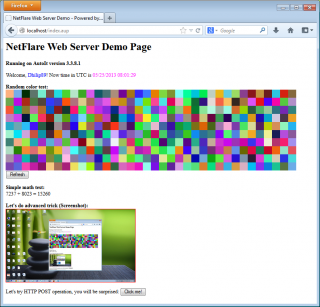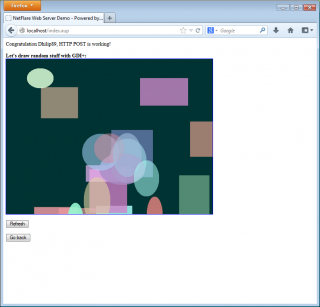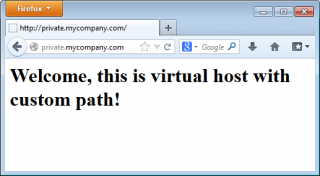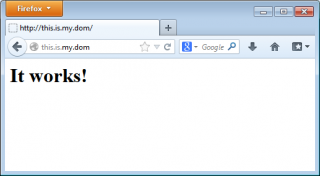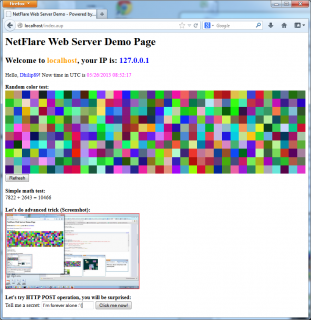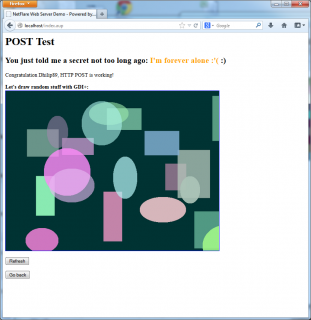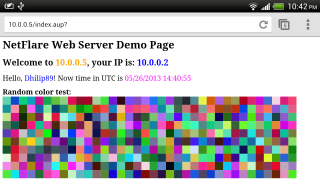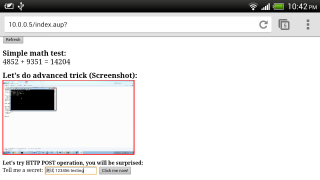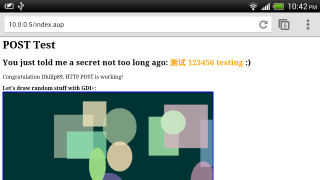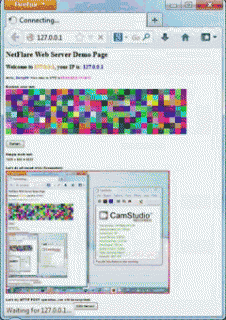Search the Community
Showing results for tags 'web server'.
-
What is NetFlare Web Server? NetFlare is a standalone web server written in pure AutoIt3 with some features: Virtual Hosts Server-side scripting For testing virtual host capability, editing etchosts file is required in most cases. File: C:WindowsSystem32driversetchosts 127.0.0.1 this.is.my.dom 127.0.0.1 private.mycompany.com Souce code (Daemon Main): #include "./Lib/Net/Http/HttpServer.au3" #include "./Lib/IO/Console.au3" _Main() Func _Main() HttpServer_SetPort(80) HttpServer_RegisterHost("this.is.my.dom") HttpServer_RegisterHost("private.mycompany.com", @ScriptDir & "\WebRoot\custompath\deeper\private.mycompany.com") ConsoleWrite("NetFlare Web Server 0.2, By Dhilip89" & @CRLF & @CRLF) ConsoleWrite("Registered virtual hosts: " & @CRLF) $HostList = HttpServer_GetRegisteredHosts() For $i = 0 To HttpServer_CountRegisteredHosts() - 1 ConsoleWrite("[" & $i+1 & "] " & $HostList[$i] & @CRLF) Next HttpServer_Start() ConsoleWrite(@CRLF & "Server is running..." & @CRLF) While 1 Sleep(1000) WEnd EndFunc - Screenshots (0.2): Screenshots (0.3): Animated GIF (Stress testing, using meta refresh): <= Click or download to view Download Links: (Version 0.1): http://www.mediafire.com/download/an1gngni6qeh5x9/NetFlare_v0.1.zip (Version 0.2): http://www.mediafire.com/download/3a88m1sgyrth48a/NetFlare_v0.2.zip (Version 0.3): http://www.mediafire.com/download/q3prydlbkygl7jd/NetFlare_v0.3.zip
-
So here's what I'm trying to accomplish: I need the ability to restart an application on my desktop PC from within my home network. Obviously, writing a script to do that locally would take all of ten seconds. The trick is that I want to do it remotely. I still feel like it wouldn't be difficult to accomplish with a server/client script. But of course, that's not good enough. I want to do it from my iPhone. And the easiest way I can see to accomplish that would be through the browser. So in my mind, I'm thinking that, on the server side, I can listen for connections on, let's say port 8080. I can watch for a "GET / HTTP/1.1" (or whatever it is...) and respond with a simple webpage that reports a status and has a reset button. On my phone, I type, say 192.168.1.150:8080 and get that simple page. When I click the reset button, it sends a "GET /?reset=true" or something and that will trigger a function in the server script to reset the app. So in essence, this would be a very simple web server, one that only serves a single, hardcoded page. But this seems too simple. Is it? Or is it actually way more complicated than that?
- 2 replies
-
- server
- web server
-
(and 2 more)
Tagged with:
-
Hi, I made an AutoIt offline web server, inspired by TiddlyWiki personal web notebook. Offline because its purpose is serving locally so we can write local files via any web browser. Just like what TiddlySaver do but without irritating security warning and no cross-domain xhr limitation. Unlike web server around it so simple (no setup), portable, works in limited-user account and integrate itself to windows explorer. It was started to simply make local pages writable (the reason I made UDF ) but then grow to (optionally) provide settings for more advanced usage i.e. enable CGI support, mapping paths, etc. So it now also can be used, for example, as PHP test environment. It supposed to be driven by internal AuJS active page (not completed yet) but these are the preview: serving phpinfo() with SQLite support: the SQLite test page (from XAMPP ) can be found in download. running CKFinder: running AjaXplorer: and php encode explorer (current directory lister, until AuJS is ready) : Basically it can work with any CGI executable I believe it can use AuCGI too. Wouldn't it be nice to have LocalHOTs and AuCGI works together as both made by AutoIt But because I still have to make AuJS can handle multipart POST data and add FLV streaming support I would be very grateful if someone willing to play with this beta and provide AuCGI samples to be packed with the release version. To run the server, execute LocalHOTs.au3 in sourcedebug folder. Once the server run, "Open with LocalHOTs" context menu on windows explorer will be available for *.htm, *.html and *.php (yes you can add *.au3 too, just follow instruction at the console). The code itself only weighted 355KB but the download bloated into 5Megs because I include PHP5 executable (required by current directory listing script) for your convenience. The tests folder contains some pages for you to start play with. Other file that may be useful is Test.all.au3, it will run test unit for both AuJS and JScriptObject UDF. It supposed to be all passed, but if you see any reds (failed test) please report it here. Update: Added FLV & MP4 HTTP Pseudostreaming Eventhough the file is served locally, web player can't jump into time that have not been buffered yet by the player. Streaming enable to seek in the timeline to any positions. Requirements: FLV Streaming - flv streaming is out of the box feature, but to prepare flv files ready for streaming you will need flvmeta, download here (win32/64). This tool will inject keyframes metadata into flv files so web player can use pseudostreaming. Just put flvmeta.exe in script folder, it will check and update flv files when necessary. MP4 Streaming - mp4 streaming depends on ffmpeg, download windows build (32/64) here. Put ffmpeg.exe file in the script folder Samples: tests/Streaming/flowplayer/example/readme.(flv|mp4).html tests/Streaming/JWPlayer/readme.(flv|mp4).html Note: copy any flv and mp4 file into tests/Streaming/media/ folder and rename it to movie.flv and movie.mp4. These files will be used by both flowplayer and JWPlayer samples. Downloads LocalHOTs beta and LocalHOTs_beta.update.rar *** UPDATE *** done: AuJS (ASP like page renderer) for *.aujdropped dir listing, popping explorer insteadlive flv stream (from any movie format), no disk cache.
-
- web server
- AuCGI
-
(and 4 more)
Tagged with:

